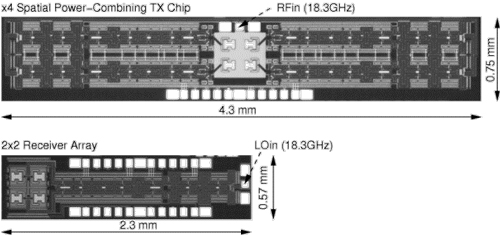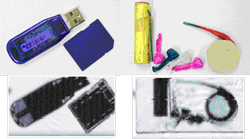- News
23 February 2011
DOTFIVE presents high-speed SiGe HBTs at ISSCC
At this week’s International Solid State Circuit Conference (ISSCC 2011) in San Francisco (20–24 February), the European research consortium DOTFIVE is detailing its latest high-speed circuits.
Running from February 2008 to end-January 2011, the three-year, €14.75m project DOTFIVE included funding of €9.7m from the European Commission, making it the largest ‘More than Moore’ nanoelectronics project under the European Union’s Seventh Framework Program (FP7) for Research and Technology Development.

Figure 1: Micrographs of fully integrated SiGe chip-set for THz imaging applications, to be presented at ISSCC.
DOTFIVE design teams have made use of silicon-germanium (SiGe) process technologies developed in Europe. The technology is targeted at future THz imaging, radar, or communication applications.
The DOTFIVE consortium claims that, over the last 3 years, it has established a leadership position for the European semiconductor industry in silicon-germanium heterojunction bipolar transistors (SiGe HBTs) for millimeter-wave applications, with contributions from semiconductor manufacturers including STMicroelectronics, Infineon Technologies and IHP GmbH. Chips based on SiGe feature faster NPN transistors and target integration levels unseen in any other high-frequency silicon bipolar technology.
Germany’s University of Wuppertal and IHP discuss circuit results of DOTFIVE’s next-generation SiGe BiCMOS technology, an imaging chip-set for applications at 0.82THz. The chips-set (a transmitter and receiver) include all required circuitry (such as frequency multipliers, harmonic mixers, power amplifiers, and on-chip antennas) and run from a 18GHz frequency reference. The circuits operate their transistors sub-harmonically and expand their application beyond their cut-off frequency. Overall, this demonstrates the “highest frequency of operation in SiGe history”, it is claimed.
The chips include some of the latest process technologies and focus on novel applications for silicon technologies, says Dr Erik Öjefors, circuit designer at the University of Wuppertal. The DOTFIVE project´s transistors are not only designed for high-frequency applications, but also enable lower-power applications and better noise performance at lower frequencies. The technology could also be a key driver for novel applications in a variety of emerging applications in the security, medical and scientific area, it is reckoned.
Prior to ISSCC, the latest DOTFIVE technology achievements were presented by IHP last December at the IEDM 2010 meeting in San Francisco. The technology features HBTs with a maximum oscillation frequency (fmax) of 500GHz, and has reached ring-oscillator gate delays as low as 2.0ps, which is a new world record for SiGe according to IHP's Dr Bernd Heinemann.
 Figure 2: Visual images (top) and THz images (below) of objects screened at 0.82THz. Images were captured with an integrated silicon solution; no expensive THz equipment was required.
Figure 2: Visual images (top) and THz images (below) of objects screened at 0.82THz. Images were captured with an integrated silicon solution; no expensive THz equipment was required.
Last September in Paris, France, the designers and technologists E. Öjefors, F. Pourchon, P. Chevalier and U.R. Pfeiffer of STMicroelectronics and the University of Wuppertal were awarded the 40th EuMC Microwave Prize (a prize given since 1977 for the best contributed paper to the European Microwave Conference) for their work ‘A 160GHz Low-Noise Downconverter in a SiGe HBT Technology’.
Also, at the 2010 BiPolar/BiCMOS Circuits and Technology Meeting (BCTM) in Austin, TX (4–6 October), Infineon presented static frequency dividers that showed record operation at 133GHz. Such circuits play a key role in any communication and radar system.
EU's DOTFIVE project to boost SiGe HBTs from 300GHz to 0.5THz
Join Semiconductor Today's LinkedIn networking and discussion group
